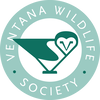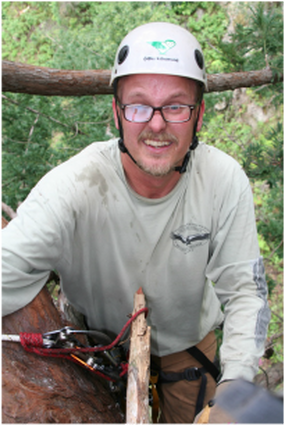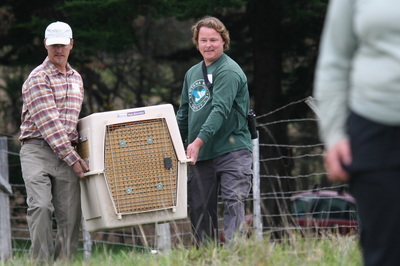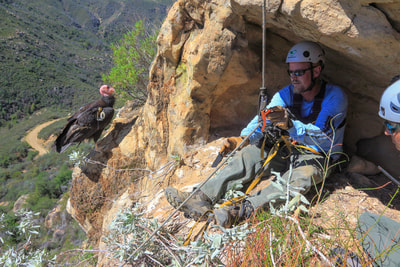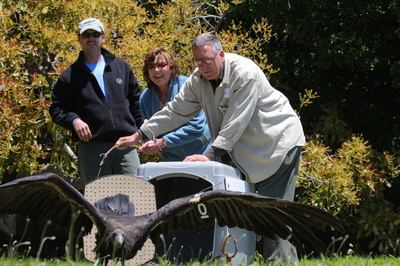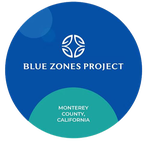Joe BurnettSenior Wildlife Biologist
California Condor Recovery Program Manager Ventana Wildlife Society 9699 Blue Larkspur Ln, Ste 105 Monterey, CA 93940 (831) 800-7424, fax (831) 455-2846 [email protected] |
-
Bio
-
Areas of Expertise
-
Videos
-
Publications
<
>
Joe first began working with Ventana Wildlife Society in May 1993 as a Field Assistant for VWS' Bald Eagle Restoration Program in Big Sur, CA. In 1996, Joe became Field Supervisor for VWS' Condor Restoration Program and coordinated the first seven releases of condors in central California, six in Big Sur and one at Pinnacles National Monument. Joe left VWS in 2003 to start up Oregon Zoo's Captive Breeding Program for condors. His experiences with captive condors vastly broadened his knowledge base of the species. In 2005, Joe returned to VWS to coordinate the release effort once again. Joe received a bachelor's degree in Wildlife and Fisheries, focusing on birds, from West Virginia University in 1994. He began his field studies of birds as an undergraduate in 1992 and now has over 25 years experience working with a variety of bird species. He is currently a two-term Monterey County Fish and Game Commissioner.
Biological monitoring
Endangered species restoration
Wildlife rehabilitation
Risk management
Public speaking
Avian Monitoring
Field Program Management
Climbing
California Condor Captive Breeding
Geographic Information Systems
Egg shell analysis
Endangered species restoration
Wildlife rehabilitation
Risk management
Public speaking
Avian Monitoring
Field Program Management
Climbing
California Condor Captive Breeding
Geographic Information Systems
Egg shell analysis
Bakker, V. J., D. R. Smith, H. Copeland, J. Brandt, R. Wolstenholme, J. Burnett, S. Kirkland, and M. E. Finkelstein. 2017. Effects of lead exposure, flock behavior, and management actions on the survival of California Condors (Gymnogyps californianus). EcoHealth 14:S92-S105.
Church, Molly E., R. Gwiazda, R. W. Risebrough, K. J. Sorenson, C. P. Chamberlain, S. Farry, W. Heinrich, B. A. Rideout, and D. R. Smith. 2006. Ammunition is the principal source of lead accumulated by California condors re-introduced to the wild. Environmental Science and Technology 40(19):6143-6150.
L. Joseph Burnett, Kelly J. Sorenson, Joseph Brandt, Estelle A. Sandhaus, Deborah Ciani, Michael Clark, Chandra David, Jenny Theule, Susie Kasielke and Robert W. Risebrough. Eggshell Thinning and Depressed Hatching Success in California Condors Reintroduced to Central California. 2013. The Condor 115(3):477-491.
Kelly T. R., J. Grantham, D. George, A. Welch, J. Brandt, L. J. Burnett, K. J. Sorenson, M. Johnson, R. Poppenga , D. Moen, J. Rasico, J. Rivers, C. Battistone, and C.K. Johnson. 2014. Shifts toward greater independence increases risk of lead exposure for re-establishing endangered California condors. Conservation Biology.
Finkelstein, M. E., D. F. Doak, D. George, J. Burnett, J. Brandt, M. Church, J. Grantham, and D. R. Smith. 2012. Lead poisoning and the deceptive recovery of the critically endangered California Condor. Proceedings of the National Academy of Sciences 109:11449-11454.
Kurle, C.M., Bakker, V.J., Copeland, H., Burnett, J., Jones, S. Scherbinski, J., Brandt, J. and Finkelstein, M.E., 2016. Terrestrial scavenging of marine mammals: Cross-ecosystem contaminant transfer and potential risks to endangered California condors (Gymnogyps californianus). Environmental science & technology, 50(17), pp.9114-9123.
Sorenson, K.J. and L.J. Burnett. 2007. Lead concentrations in the blood of Big Sur California condors. Pages 185-195 in California Condor in the 21st Century. Series in Ornithology, No. 2.
Sorenson, K.J, L.J. Burnett, and M. M. Stakes. 2017. Restoring a Bald Eagle breeding population in central California and monitoring 25 Years of regional population growth. Journal of Raptor Research, In Press July 2017.
Church, Molly E., R. Gwiazda, R. W. Risebrough, K. J. Sorenson, C. P. Chamberlain, S. Farry, W. Heinrich, B. A. Rideout, and D. R. Smith. 2006. Ammunition is the principal source of lead accumulated by California condors re-introduced to the wild. Environmental Science and Technology 40(19):6143-6150.
L. Joseph Burnett, Kelly J. Sorenson, Joseph Brandt, Estelle A. Sandhaus, Deborah Ciani, Michael Clark, Chandra David, Jenny Theule, Susie Kasielke and Robert W. Risebrough. Eggshell Thinning and Depressed Hatching Success in California Condors Reintroduced to Central California. 2013. The Condor 115(3):477-491.
Kelly T. R., J. Grantham, D. George, A. Welch, J. Brandt, L. J. Burnett, K. J. Sorenson, M. Johnson, R. Poppenga , D. Moen, J. Rasico, J. Rivers, C. Battistone, and C.K. Johnson. 2014. Shifts toward greater independence increases risk of lead exposure for re-establishing endangered California condors. Conservation Biology.
Finkelstein, M. E., D. F. Doak, D. George, J. Burnett, J. Brandt, M. Church, J. Grantham, and D. R. Smith. 2012. Lead poisoning and the deceptive recovery of the critically endangered California Condor. Proceedings of the National Academy of Sciences 109:11449-11454.
Kurle, C.M., Bakker, V.J., Copeland, H., Burnett, J., Jones, S. Scherbinski, J., Brandt, J. and Finkelstein, M.E., 2016. Terrestrial scavenging of marine mammals: Cross-ecosystem contaminant transfer and potential risks to endangered California condors (Gymnogyps californianus). Environmental science & technology, 50(17), pp.9114-9123.
Sorenson, K.J. and L.J. Burnett. 2007. Lead concentrations in the blood of Big Sur California condors. Pages 185-195 in California Condor in the 21st Century. Series in Ornithology, No. 2.
Sorenson, K.J, L.J. Burnett, and M. M. Stakes. 2017. Restoring a Bald Eagle breeding population in central California and monitoring 25 Years of regional population growth. Journal of Raptor Research, In Press July 2017.
